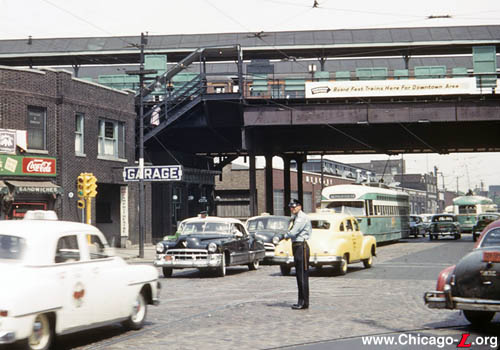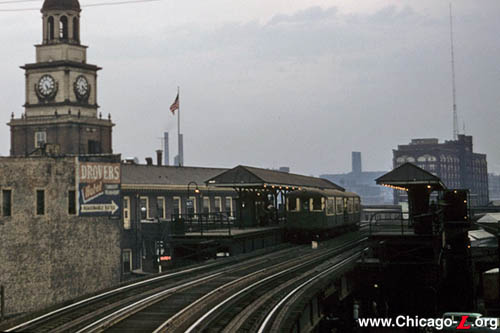
The Stock Yards branch's Halsted station is visible beyond the intersection of Halsted and Root, looking north during the Democratic Convention on July 9, 1952. The station house is visible underneath the elevated structure on the left. A train of brown-and-orange-painted steel 4000-series cars is visible above in the station -- these cars were specially assigned to the branch during the convention. Service on the Stock Yards branch was normally held down with older wooden cars.
For a larger view,
click here.
(George Krambles photo, courtesy of the Krambles-Peterson Archive)
|
Halsted
(4100S/800W)
Halsted Street and Root
Street, Canaryville (New City)
Service
Notes:

|
Stock Yards
Line
|
Quick Facts:
Address: TBD
Established: April 8, 1908
Original Line: South Side Elevated Railroad, Stock Yards
branch
Previous Names: none
Skip-Stop Type: n/a
Rebuilt: n/a
Status: Demolished
History:
Halsted was one of only two stations on the Stock Yards branch located outside the Stock Yards. The line was built specifically to
carry workers from their South Side homes to the Yards. It was never
intended to reach the Loop; instead it was built to run shuttles to
the Indiana Avenue station, which is just
about all that even ran on the line, although some services sporadically also ran north of Indiana and south to the Jackson Park branch.
The facility at Halsted consisted of a
grade-level station house on the west side of the street, with stairs from the rear of the building leading to dual side boarding platforms at the elevated track level. The station house resembled the headhouse designed by architect
Earl Nielson at Racine, as well as other South Side stations of the same era at 42nd Place, Halsted/63rd, and 69th. The station house was constructed of brick, which an articulated cornice, triglyphs and pilasters, giving it a Greek Revival influence similar to the aforementioned stations. Halsted's wood-decked side platforms were each covered by
a peaked-roof canopy of steel supports down the middle of the platform with a gently-curved
bracket and intricate latticework supporting a hipped corrugated
metal roof.
By the mid-1950s, it was becoming apparent that falling ridership
and increasing deterioration of the Stock Yards branch and its cousin,
the Kenwood branch, would require some sort of immediate action. Three
plans were formulated for how to continue service -- purchasing the
route from the Chicago Junction Railway (from whom CTA rented the
property), continue to lease it from the CJRwy, or purchase of the property by an outside
agency for CTA use -- but all of these included modernization of the
Halsted station. As part of a $3,100 modernization plan covering both
the Kenwood and Stock Yards lines, drawings dated July 11, 1956 show
that Halsted would have had its station house removed. A smaller
space formally occupied by the station would have been black-topped
with a drip pan installed overhead on the elevated structure . High
fencing was to be installed around the new fare collection
area, leading to the existing dual staircases up to the station platforms. A
two-position agents booth, "fare-o-mat" turnstiles, and transfer issuing machines were to
be provided. In all, it would have probably looked similar to the
chain link "stations" that were once present at Indiana, Wellington,
and Hoyne stations, and still today at Lawrence station.
Other factors, however, would seal the Stock Yards branch's fate.
Due to changes in the meat packing industry, the Union Stock Yards
became redundant and outdated, and was closed. Now with its main
purpose gone, the Stock Yards branch followed suit, ending "L"
service October 7, 1957.

Halsted station is seen in August 1956. A 4000-series train, by this time in the green-and-cream livery they would serve out their remaining years in, is berthed in the station -- these cars were once again specially assigned to the branch for convention duty, with the Democratic Convention again being held a block south at the International Amphitheater. For a larger view,
click here. (William C. Janssen photo, courtesy of the Krambles-Peterson Archive) |


|
halsted01.jpg (147k)
A fire in the Stock Yards in May 1934 consumed everything in its path, including a two-car train trapped west of Halsted, whose platform railing can be seen in the lower left corner.(Photo from the Krambles-Peterson Archive) |





